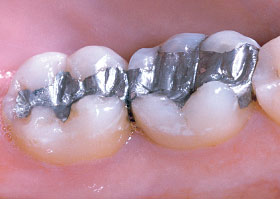Silver Fillings — Safe or Unsafe?
A review of the scientific literature
Dear Doctor,
I have been reading about concerns with silver fillings because of their mercury content, and I'm wondering if tooth-colored fillings are better. Can you give some advice?

Dear Meredith,
It seems the question for our era is how do you know what's right for you? To help you understand, we will briefly discuss the advantages and disadvantages of both. However, regardless of which materials are used, the process is nearly the same. The dentist “prepares” the tooth, removes decay, and places the filling directly into the tooth during one appointment.
Properties of materials chosen for dental restorations include: performance under chewing or biting function, durability, longevity, cost and ease of placement. The utmost considerations include safety and biological compatibility with very low incidence of allergic response. But let's get right to the point about silver fillings commonly known as dental amalgam. The American Dental Association (ADA) states, “Dental amalgam has been used by dentists for more than a century and is the most thoroughly researched and tested restorative material among all those in use today.”
But what is a dental amalgam? Dental amalgam is a stable alloy made by combining mercury, silver, tin, and copper in carefully controlled proportions and mixed into a precise blend so there is no free or excess mercury. The mixture is plastic or moldable initially, but “sets” hard. Mercury in amalgam combines with other metals to render it stable and safe. According to the ADA, “There is no ‘free’ mercury that can enter the blood circulation where it could cause damage to the nervous system — the biggest concern.” The ADA further states, “While questions have arisen about the safety of dental amalgam relating to its mercury content, the major US and international scientific and health bodies, including the National Institutes of Health, the US Public Health Service, the Centers for Disease Control and Prevention, the Food and Drug Administration and the World Health Organization, among others have been satisfied that dental amalgam is a safe, reliable and effective restorative material.”
While there are very low levels of mercury vapor that may come off the amalgam during chewing that could be inhaled or ingested, these trace amounts are well below the amount that could cause harm. In fact, scientific studies have found no ill effects in adults or children age six and older from using dental amalgam fillings.
Advantages of dental amalgam: Those included are biocompatibility (not allergy producing or toxic), durability, ease of use, relative high resistance to wear and low expense. It is a valuable option in the right circumstances because it can withstand very high chewing loads for molar (back) teeth. It is also useful in areas where a cavity is difficult to keep dry during the filling replacement, such as in deep fillings below the gum line.
Disadvantages: Because of its silver appearance, it is unacceptable aesthetically for front teeth. Also, metal transmits temperature well, so there can sometimes be possible short-term sensitivity to hot or cold, especially with large fillings. Amalgam fillings may also require more tooth structure removal to keep them in place.
Alternatives To Amalgam
Composite resin fillings are a mixture of glass or quartz filler in a resin medium that produces a tooth-colored filling. Also referred to as composites or filled resins, they match teeth, transmit light well and can make imperceptible tooth restorations; however, they are subject to stain and discoloration over time. They provide good durability and resistance to fracture in small- to mid-size restorations that need to withstand moderate chewing pressure. Composites can also be physically bonded to tooth structure, often allowing a more conservative repair. Their cost is moderate depending upon size.
Glass ionomers are translucent, tooth-colored materials made of a mixture of acrylic acids and fine glass powders that are used to fill cavities, particularly those on the root surfaces of teeth. When the dentist prepares the tooth for a glass ionomer, less tooth structure can be removed, often resulting in a smaller filling than that of an amalgam. They are primarily used in areas not subject to heavy chewing pressure. And because they have a low resistance to fracture, glass ionomers are mostly used in those fillings between teeth or on tooth roots. They also release a small amount of fluoride that may be beneficial for teeth with high risk for decay.
Resin ionomers are also made from glass filler with acrylic acids, fine glass powders and acrylic resin. They are used for very small fillings between teeth and are only moderately resistant to fracture, making them useful in non-biting surface areas like tooth root surfaces. Both glass and resin ionomers mimic natural tooth color but lack the natural translucency of enamel and experience high wear when placed on chewing surfaces. They are well tolerated by patients with only rare instances of allergic reaction.
The ultimate decision about what to use and when is best determined in a consultation with your dentist. You should discuss your concerns and the risks/benefits of all filling materials available, including your susceptibility to tooth decay, so that you maintain optimal oral health.

